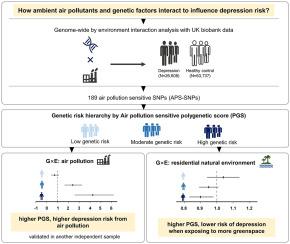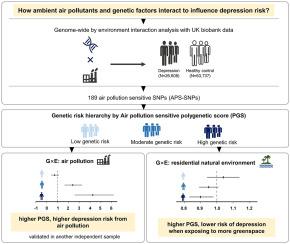Genetic sensitivity moderates the effects of joint exposure to air pollution on depression risk: a genome-wide by environment interaction analysis
IF 7.3
2区 环境科学与生态学
Q1 ENVIRONMENTAL SCIENCES
引用次数: 0
Abstract
How ambient air pollutants and genetic factors interact to influence depression risk remains unclear. This study aims to investigate how genetic factors regulate the relationship between air pollution and depression. Using UK Biobank data, an air pollution index was constructed from NO2, NOx, PM2.5, PM2.5-10 and PM10 to assess joint exposure. A genome-wide interaction analysis identified 189 air pollution-sensitive SNPs (APS-SNPs) enriched in neurodevelopment. Polygenic scores (PGS) constructed by APS-SNPs showed significant interaction with the air pollution index, NO2, NOx, PM2.5 and PM10 on depression risk (all P < 0.05). Individuals with high PGS had a greater depression risk from air pollution index (OR = 3.17, 95 %CI: 2.63-3.83). Interaction effects between PGS and NO2 and PM2.5 were validated in the independent sample. PGS also interacted with greenspace percentage, natural environment percentage, and water percentage. Individuals with high PGS had a significantly lower risk of depression when exposing to more greenspace (buffer 300m, OR = 0.91, 95 %CI: 0.83–0.99; buffer 1000m, OR = 0.90, 95 %CI: 0.83–0.98). Our findings identified that joint exposure to various air pollutants increases depression risk, moderated by genetic factors, and modifying life environments could be an effective intervention for those genetically sensitive to environmental factors.


遗传敏感性调节联合暴露于空气污染对抑郁症风险的影响:全基因组环境相互作用分析
环境空气污染物和遗传因素如何相互作用影响抑郁症风险尚不清楚。本研究旨在探讨遗传因素如何调节空气污染与抑郁症之间的关系。利用英国生物银行(UK Biobank)的数据,构建了NO2、NOx、PM2.5、PM2.5-10和PM10的空气污染指数来评估关节暴露。一项全基因组相互作用分析确定了189个空气污染敏感snp (aps - snp),这些snp在神经发育中富集。aps - snp构建的多基因评分(PGS)与空气污染指数、NO2、NOx、PM2.5和PM10对抑郁风险的交互作用显著(P < 0.05)。高PGS个体的抑郁风险与空气污染指数相关(OR = 3.17, 95%CI: 2.63 ~ 3.83)。在独立样本中验证了PGS与NO2和PM2.5之间的交互效应。PGS还与绿地百分比、自然环境百分比和水百分比相互作用。高PGS个体在暴露于更多绿地(缓冲300米,OR=0.91, 95%CI: 0.83-0.99;缓冲1000米,OR=0.90, 95%CI: 0.83-0.98)时,抑郁风险显著降低。我们的研究发现,联合暴露于各种空气污染物会增加抑郁症的风险,受遗传因素的调节,改变生活环境可能是对那些对环境因素遗传敏感的人的有效干预。
本文章由计算机程序翻译,如有差异,请以英文原文为准。
求助全文
约1分钟内获得全文
求助全文
来源期刊

Environmental Pollution
环境科学-环境科学
CiteScore
16.00
自引率
6.70%
发文量
2082
审稿时长
2.9 months
期刊介绍:
Environmental Pollution is an international peer-reviewed journal that publishes high-quality research papers and review articles covering all aspects of environmental pollution and its impacts on ecosystems and human health.
Subject areas include, but are not limited to:
• Sources and occurrences of pollutants that are clearly defined and measured in environmental compartments, food and food-related items, and human bodies;
• Interlinks between contaminant exposure and biological, ecological, and human health effects, including those of climate change;
• Contaminants of emerging concerns (including but not limited to antibiotic resistant microorganisms or genes, microplastics/nanoplastics, electronic wastes, light, and noise) and/or their biological, ecological, or human health effects;
• Laboratory and field studies on the remediation/mitigation of environmental pollution via new techniques and with clear links to biological, ecological, or human health effects;
• Modeling of pollution processes, patterns, or trends that is of clear environmental and/or human health interest;
• New techniques that measure and examine environmental occurrences, transport, behavior, and effects of pollutants within the environment or the laboratory, provided that they can be clearly used to address problems within regional or global environmental compartments.
 求助内容:
求助内容: 应助结果提醒方式:
应助结果提醒方式:


